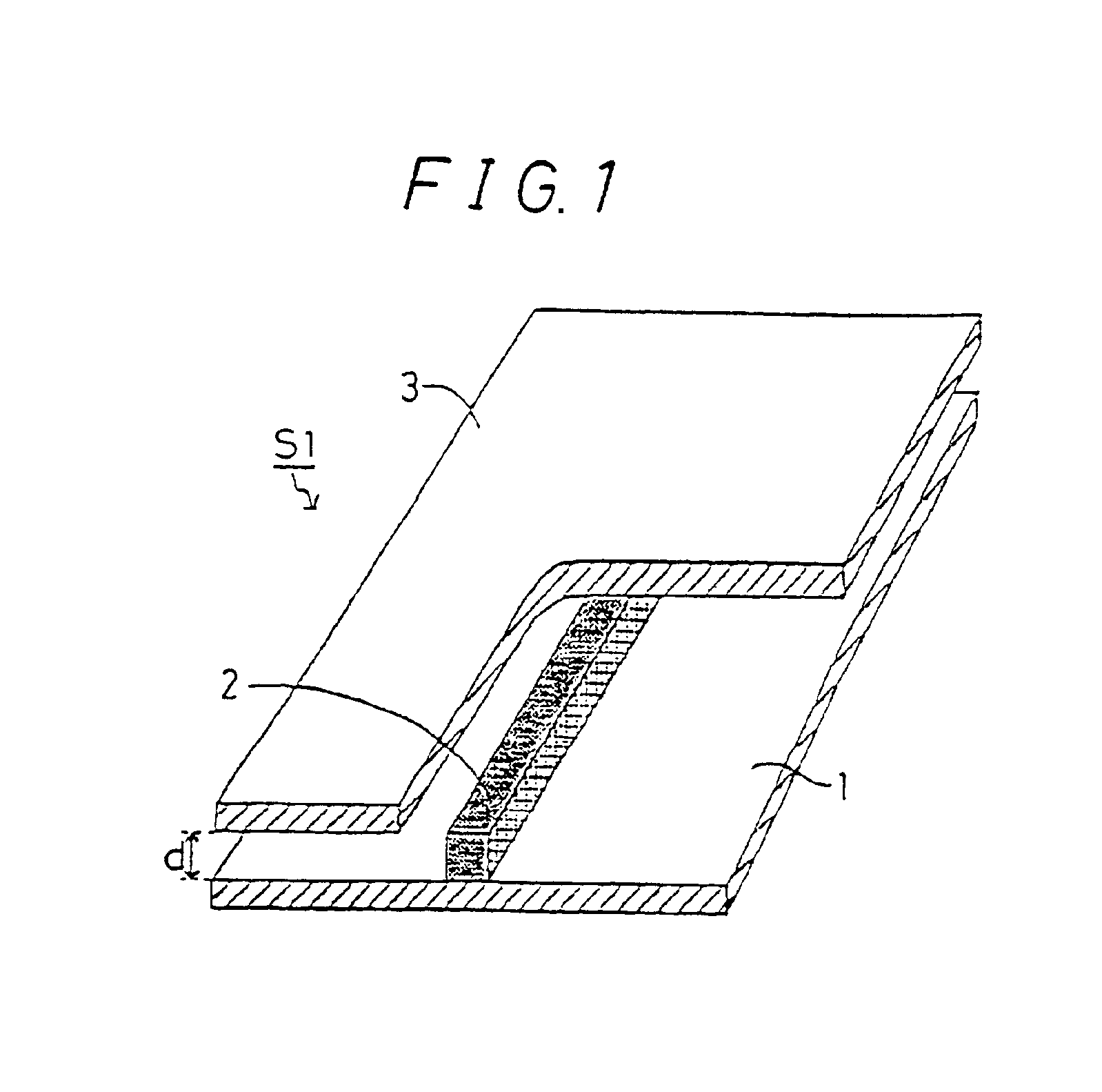Non-radiative dielectric waveguide and millimeter wave transmitting/receiving apparatus
a dielectric waveguide and millimeter wave technology, applied in the direction of waveguides, electrical devices, coupling devices, etc., can solve the problems of increasing the bonding area, and achieve the effects of reducing the loss of high-frequency signal transmission, excellent reliability, and reducing the radius of curvatur
- Summary
- Abstract
- Description
- Claims
- Application Information
AI Technical Summary
Benefits of technology
Problems solved by technology
Method used
Image
Examples
example 1
[0126]An NRD guide S1 as shown in FIG. 1 was constructed as follows. As materials for the dielectric strip 2, ceramics with varying composition ratios were prepared that include a complex oxide comprising Mg, Al and Si as a main component. Their relative dielectric constants and Q values at a frequency of 60 GHz will be shown in Table 1.
[0127]
TABLE 1RelativeComposition (mol %)dielectricQ valueMgOAl2O3SiO2Additive(wt %)constant(60 GHz)155540Yb2O3106.85202101080Yb2O3104.814003103060Yb2O3155.818204104050Yb2O30.15.818505153550Yb2O355.62121617.517.565Yb2O354.820407204040Yb2O355.61010822.222.255.6——4.728109251758Yb2O3105.1249010252748Yb2O3105.627701125.53044.5Yb2O3105.8212012301060Yb2O355.2150013303040Yb2O355.6250014352045Yb2O3106.0206015353530Yb2O30.15.8208016401050Yb2O3105.8199017402040Yb2O355.5102018404020Yb2O3106.0147019405010Yb2O357.952020581032Yb2O357.512502122.222.255.6Yb2O30.14.829102222.222.255.6Yb2O314.826702322.222.255.6Yb2O354.827502422.222.255.6Yb2O374.930102522.222.255.6Yb2O...
example 2
[0130]A pair of parallel planar conductors 1 and 3, each of which is made of an aluminum metal plate which is 80 mm long, 80 mm wide, and 2 mm in thickness, were arranged in parallel at a distance d of 1.8 mm. A dielectric strip 2 made of the cordierite ceramics as numbered 24 in Table 1 was placed between the parallel planar conductors 1 and 3. The sectional configuration of the dielectric strip 2 assumes a rectangular shape with a height of about 1.8 mm and a width of about 0.8 mm. The dielectric strip 2 had an open pore ratio of 0.5%. The surface roughness of the inner surface of the metal plate was measured by using a tracer-type surface roughness measuring machine, and the result was 0.3 μm. The metal plate and the dielectric strip 2 were bonded together with one-component epoxy resin. Transmission loss in high-frequency signals was measured by a network analyzer at a frequency of 76.5 GHz, and the result was 0.18 dB / cm. This means that the transmission loss is sufficiently sma...
example 3
[0132]Another NRD guide S1 as shown in FIG. 1 was constructed basically in the same manner as in Example 1 except that, in the former, at each edge portion of the dielectric strip 2 is formed a chamfer 2a forming a plane and having a width H of 0.1 mm with respect to the faces 2c opposing to the parallel planar conductors, and a width H1 of 0.05 mm with respect to the side faces 2b (H>H1), as shown in FIG. 7C. Transmission loss in high-frequency signals was measured and the result was 0.16 dB / cm, which means that the transmission loss is sufficiently small in practice.
PUM
 Login to View More
Login to View More Abstract
Description
Claims
Application Information
 Login to View More
Login to View More - R&D
- Intellectual Property
- Life Sciences
- Materials
- Tech Scout
- Unparalleled Data Quality
- Higher Quality Content
- 60% Fewer Hallucinations
Browse by: Latest US Patents, China's latest patents, Technical Efficacy Thesaurus, Application Domain, Technology Topic, Popular Technical Reports.
© 2025 PatSnap. All rights reserved.Legal|Privacy policy|Modern Slavery Act Transparency Statement|Sitemap|About US| Contact US: help@patsnap.com



